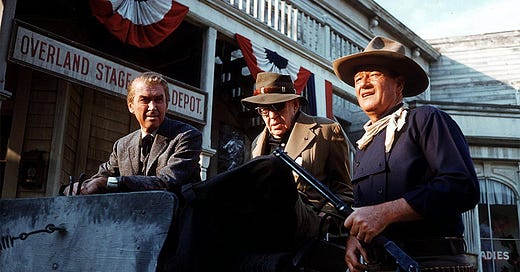100 Movies Every Catholic Should See #105: The Man Who Shot Liberty Valance (1962)
Directed by John Ford. Starring John Wayne and Jimmy Stewart
Storytelling is identity-making. Whenever we tell a story about ourselves or about the world, we tell ourselves and the world who we are and what the world is. The Man Who Shot Liberty Valance, then, is a film about the identity of a man, a region, and a nation. But Liberty is not just any film—it’s a Western.
Western films are movies set in the American Old West in the latter half of the 19th century. From 1940 to 1960, Hollywood averaged producing about 50 Westerns per year (of varying quality). Thus, this two-decade period rightly boasts the name “The Golden Age of the Western.” More so than the actual age of the Cowboy, this period solidified the Wild West in the American imagination as a prior age of daring cowboys and desert-hardened outlaws. The classic Western (watch Shane or High Noon) developed a cinematic language that included Cowboys & Gunslingers, Immigrants & Indians, and Outlaws & Bounty Hunters. These characters met on the stage of the American frontier, in deserts, prairies, small towns, saloons, and ranches. Viewers at the time could clearly see the 'genre' of the Western through this shared visual language and kept demanding more and more. The Western was an endless frontier for moviemakers, yielding more and more cash as time went on—but such golden ages cannot last forever.
In time, all genres of cinema must become stale. A similar thing has happened in the 21st century with superhero movies. For comparison, Hollywood only made about 200 superhero movies between 2005 and 2025. If you think superhero movies are overdone, imagine having five times that many movies, and you can begin to consider the massive impact the West had on cinema during its time. It’s natural that, by 1960 or so, audiences may have cooled to the same repeated language of Red River or The Magnificent Seven in the same way that 2025 audiences have cooled to the superhero movie. But as the golden age of the Western ended, filmmakers were hardly done making them.
Four Academy Awards went to John Ford during his lifetime; he is the most honored director in film history and the Western movie director, par excellence. With a directing career that began while the Czars were still in power, John Ford crafted more than 130 films over his 53-year directing tenure. Some of his best films include How Green Was My Valley (1941), 3 Godfathers (1948), and The Searchers (1956). Viewers came to love the rich vistas elegantly framed by Ford’s painterly eye. Shooting for the most part on location, Ford arranged his high dramas on some of the most beautiful stages imaginable in Monument Valley. His Western films especially sing with technicolor glory and dazzle the eye even on a small screen.
John Ford’s The Man Who Shot Liberty Valence possesses none of the visual vistas or colors that made Ford's name synonymous with the Western. Liberty comes right at the end of this golden age of the Hollywood western in 1962 and Ford shot Liberty on a sound stage in black and white. Yet, it’s exactly this smaller scale that allows Liberty to be the tonal counterpoint to the sweeping Westerns of the 1950s such as Wayne’s own The Alamo (1960) or The Big Country (1958). In Liberty, Ford takes two big stars, John Wayne and Jimmy Stewart, and compresses them into a genre-defying Western Noir film that is as thoughtful as it is thrilling.
Since storytelling is identity-making, films that depict other eras of history are especially interesting. When watching The Man Who Shot Liberty Valence, I encourage you to consider three temporal things. 1) What does this film say about the time that it depicts? 2) What does this film say about its own time? And 3) What does our reaction to this film over half a century later say about our time?
The Man Who Shot Liberty Valence takes place in a nameless western territory on the cusp of statehood. Ransom Stoddard (Jimmy Stewart) graduates law school and arrives in the Old West only to be robbed along the way by Liberty Valence, who leaves him inches from death beside his tattered law books. Civilization and Law (represented by Stoddard) are moving westward and are attempting to tame chaos and lawlessness (represented by Valence). Even their names: "Ransom" and "Liberty," connote this tension between different senses of freedom. The conflict between Ransom and Liberty contains within it the entire conflict of the West at the end of the 19th century, but it’s also more than that.
While The Man Who Shot Liberty Valence treats the Old West, the movie is also about American Democracy in 1962. Pompey (Woody Strode), Wayne's Black erstwhile manservant, and Dutton Peabody (Edmund O'Brien) are supporting characters that cast important lights on civil rights and the freedom of the press in the 1960s. While the citizens of the town of Shinbone gather to vote on who will represent them at the statehood convention, Pompey sits out front, unable to vote himself, standing guard. Even though Dutton Peabody is weak-willed in his personal life when it comes to drinking, he finds the courage to print the truth about what Liberty Valence even when it means facing down physical violence. Liberty praises the qualities that make America great while also recognizing that all the heroes and villains in the story are Americans.
But what should we make of this movie now? As the language of the Western movie became stale, John Ford provided us a film with characters who, while still good and evil, are morally nuanced. Two years later, Sergio Leone’s Dollars Trilogy (1964-1966) would provide us with amoral characters who do what suits them in their own way. The Man Who Shot Liberty Valence serves us rich food for contemplation about not only what it is to be a freedom-loving American but also what it means to be a freedom-loving human being.
I hope you enjoy the film as much as I do.







Ben really appreciate this review and we are in agreement about the - way the Westerns in the Golden Age depict human nature - a classical understanding - as compared to 60s and 70s when the focus turned individualistic and subjective. Thank you so much for this analysis. We have these classic westerns like Shane and Liberty in our study guides to serve students in all settings.
Liberty Valance is one my favorites. Some of it is the little things. Pompey reading in the schoolroom. Woody Strode is understatedly perfect. Even with the weird "old man" makeup in the wrap around. I mentioned it last time with Jeffery Hunter, but again Ford's Sgt. Rutledge companions here Ford getting such great performance. The 5 brilliant minutes of John Carradine being John Carradine. Strother Martin rolling and rolling out the barroom door. Lee Marvin drawling out "Dude" with such casual malignance.
It's interesting to look at 1962, as you see Peckinpah's Ride the High Country come out that same year.. and how different.. and yet similar... the 2 are.